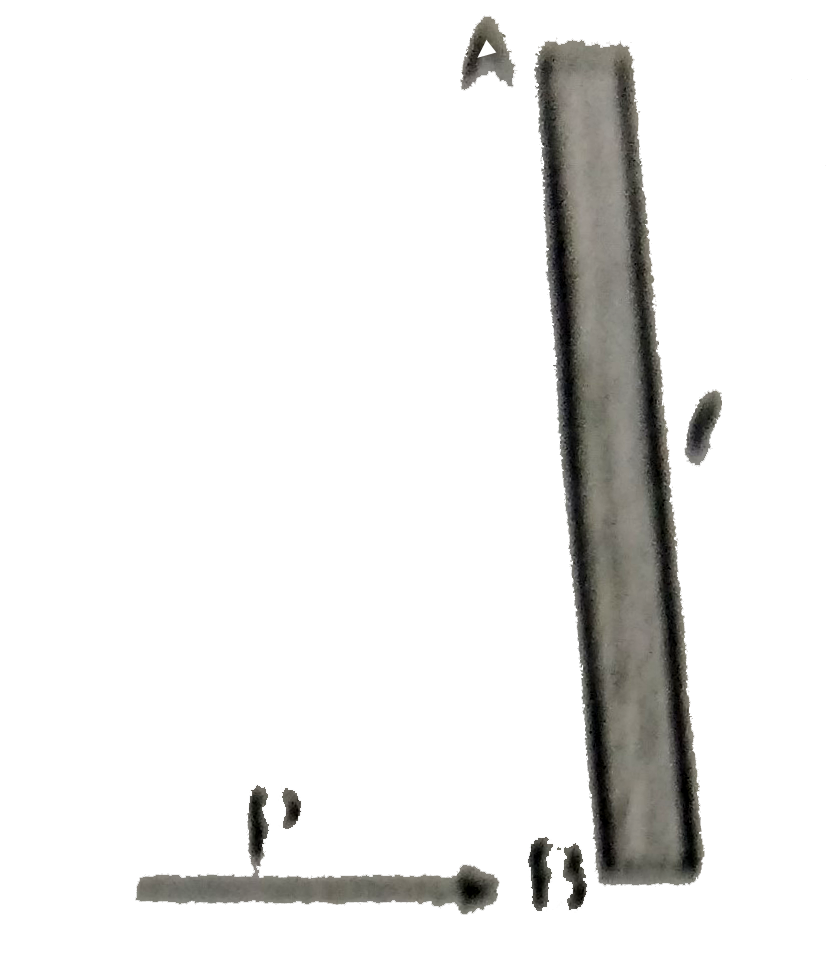A 5kg rod of square cross section 5cm on a side and 1m long is pulled along a smooth horizontal surface by a force applied at one end. The rod has a constant acceleration of 2ms−12. Determine the elongation in the rod. (Young's modulus of the material of the rod is 5×103N/m9).
Zero, as for elongation to be there, equal and opposite forces must act on the rod
Non-zero but cannot be determine from the give, situation
0.4μm
16μm
The correct Answer is:C
To determine the elongation in the rod, we will follow these steps:
Step 1: Identify the given data
- Mass of the rod, m=5kg
- Cross-sectional area, A=(5cm)2=(0.05m)2=0.0025m2
- Length of the rod, L=1m
- Acceleration, a=2m/s2
- Young's modulus, Y=5×103N/m2
Step 2: Calculate the force acting on the rod
Using Newton's second law, the force F acting on the rod can be calculated as:
F=m⋅a=5kg⋅2m/s2=10N
Step 3: Use the formula for elongation
The elongation ΔL in the rod can be calculated using the formula:
ΔL=F⋅LA⋅Y
Substituting the values we have:
ΔL=10N⋅1m0.0025m2⋅5×103N/m2
Step 4: Calculate the denominator
Calculating the denominator:
0.0025m2⋅5×103N/m2=12.5N
Step 5: Calculate the elongation
Now substituting back into the elongation formula:
ΔL=10N12.5N=0.8m
Step 6: Convert to micrometers
To express the elongation in micrometers:
ΔL=0.8m=0.8×106μm=800000μm
Final Result
The elongation in the rod is ΔL=800000μm.
---
- Mass of the rod, m=5kg
- Cross-sectional area, A=(5cm)2=(0.05m)2=0.0025m2
- Length of the rod, L=1m
- Acceleration, a=2m/s2
- Young's modulus, Y=5×103N/m2
Using Newton's second law, the force F acting on the rod can be calculated as:
F=m⋅a=5kg⋅2m/s2=10N
The elongation ΔL in the rod can be calculated using the formula:
ΔL=F⋅LA⋅Y
Substituting the values we have:
ΔL=10N⋅1m0.0025m2⋅5×103N/m2
Calculating the denominator:
0.0025m2⋅5×103N/m2=12.5N
Now substituting back into the elongation formula:
ΔL=10N12.5N=0.8m
To express the elongation in micrometers:
ΔL=0.8m=0.8×106μm=800000μm
The elongation in the rod is ΔL=800000μm.
Topper's Solved these Questions
- BOOK - CENGAGE PHYSICS ENGLISHCHAPTER - PROPERTIES OF SOLIDS AND FLUIDSEXERCISE - Multiple Correct17videos
PROPERTIES OF SOLIDS AND FLUIDS
- BOOK - CENGAGE PHYSICS ENGLISHCHAPTER - PROPERTIES OF SOLIDS AND FLUIDSEXERCISE - Assertion- Reasoning13videos
PROPERTIES OF SOLIDS AND FLUIDS
- BOOK - CENGAGE PHYSICS ENGLISHCHAPTER - PROPERTIES OF SOLIDS AND FLUIDSEXERCISE - Subjective16videos
PROPERTIES OF SOLIDS AND FLUIDS
- BOOK - CENGAGE PHYSICS ENGLISHCHAPTER - NEWTON'S LAWS OF MOTION 2EXERCISE - Integer type1videos
NEWTON'S LAWS OF MOTION 2
- BOOK - CENGAGE PHYSICS ENGLISHCHAPTER - RIGID BODY DYNAMICS 1EXERCISE - Integer11videos
RIGID BODY DYNAMICS 1
Similar Questions
A uniform rod of length L and mass M is pulled horizontally on a smooth surface with a force F. Determine the elongation of rod if Young's modulus of the material is Y.
View SolutionA rod of length L kept on a smooth horizontal surface is pulled along its length by a force F. The area of cross-section is A and Young's modulus is Y. The extension in the rod is
 View Solution
View Solution
Knowledge Check
- Question 1 - Select One
A steel bar ABCD 40cm long is made up of three parts AB,BC and CD, as shown in figure. The rod is subjected to a pull of 25kN. Determine the stress in the the parts and the total extension of the rod. Young's modulus for steel=2×1011Nm−2.
 A0.0637 mmB0.0647 mmC0.0657 mmD0.0667 mm
A0.0637 mmB0.0647 mmC0.0657 mmD0.0667 mm
A uniform rod of mass M and length L, area of cross section A is placed on a smooth horizontal surface. Forces acting on the rod are shown in the digram

Total elastic potential energy stored in the rod is :View SolutionTwo blocks A and B of masses m and 2m are placed on a smooth horizontal surface. Block B is given a speed of 3m/s. Find
(i) The maximum speed of A
(ii) The minimum speed of B.
 View Solution
View SolutionA uniform rod AB of mass m and length l at rest on a smooth horizontal surface . An impulse P is applied to the end B. The time taken by the rod to turn through a right angle is :
 View Solution
View SolutionA uniform rod AB of mass m and length l at rest on a smooth horizontal surface . An impulse P is applied to the end B. The time taken by the rod to turn through a right angle is :
 View Solution
View SolutionA metallic rod of length 1m is rigidly clamped at its mid point. Longirudinal stationary wave are setup in the rod in such a way that there are two nodes on either side of the midpoint. The amplitude of an antinode is 2×10−6m. Write the equation of motion of a point 2 cm from the midpoint and those of the constituent waves in the rod, (Young,s modulus of the material of the rod =2×1011Nm−2 , density =8000kg−m−3). Both ends are free.
View SolutionA uniform rod of length l, mass m, cross-sectional area A and Young's modulus Y is rotated in horizontal plane about a fixed vertical axis passing through one end, with a constant angular velocity ω. Find the total extension in the rod due to the tension produced in the rod.
View SolutionA rod 100 cm long and of 2cm×2cm cross-section is subjected to a pull of 1000 kg force. If the modulus of elasticity of the materials is 2.0×106kg/cm2, determine the elongation of the rod.
View Solution

